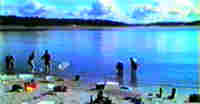|

They
are wonderful
|
|
Experiments have been carried out on protected
beaches where cages have been used to stop larger predators like crabs,
fish and birds from taking prey from the bottom. Compared with reference
areas, where predators were able to feed normally, it was shown that populations
and variety of specie increased.
Read the chapter ”To
obtain knowledge about the sea”, if you want an account of what
you must do to decide which explanation is the right one.
Seasonal and daily variations
Shallow water heats up quickly during
the spring. It is splendid for those of you who like to bathe, and it
is splendid for those animals and plants that live on the beach. Furthermore,
plants have plenty of food
and light during the spring. Therefore, can most organisms grow and reproduce.
Spring and summer immigration
Last years shrimps
and shore
crabs - that have taken refuge in deeper water during the winter -
return to the beach during the middle of the spring. Adult sand
gobies return also to shallower water to lay their eggs under mussel
shells. A little later, plaice
spawn swim in from the open sea. Here they transform into flat fish
that live on the bottom. Around midsummer or soon after, the mussel larvae
arrive. They are mostly cockles,
sand
gapers and common
mussels that come. They are very small, about 1 mm in size and can
be as many as one million per square metre. Also larvae of different polychaetes,
periwinkles and crustaceans
arrive on the beach.
|

|
Page 13
of 15
|

|
|